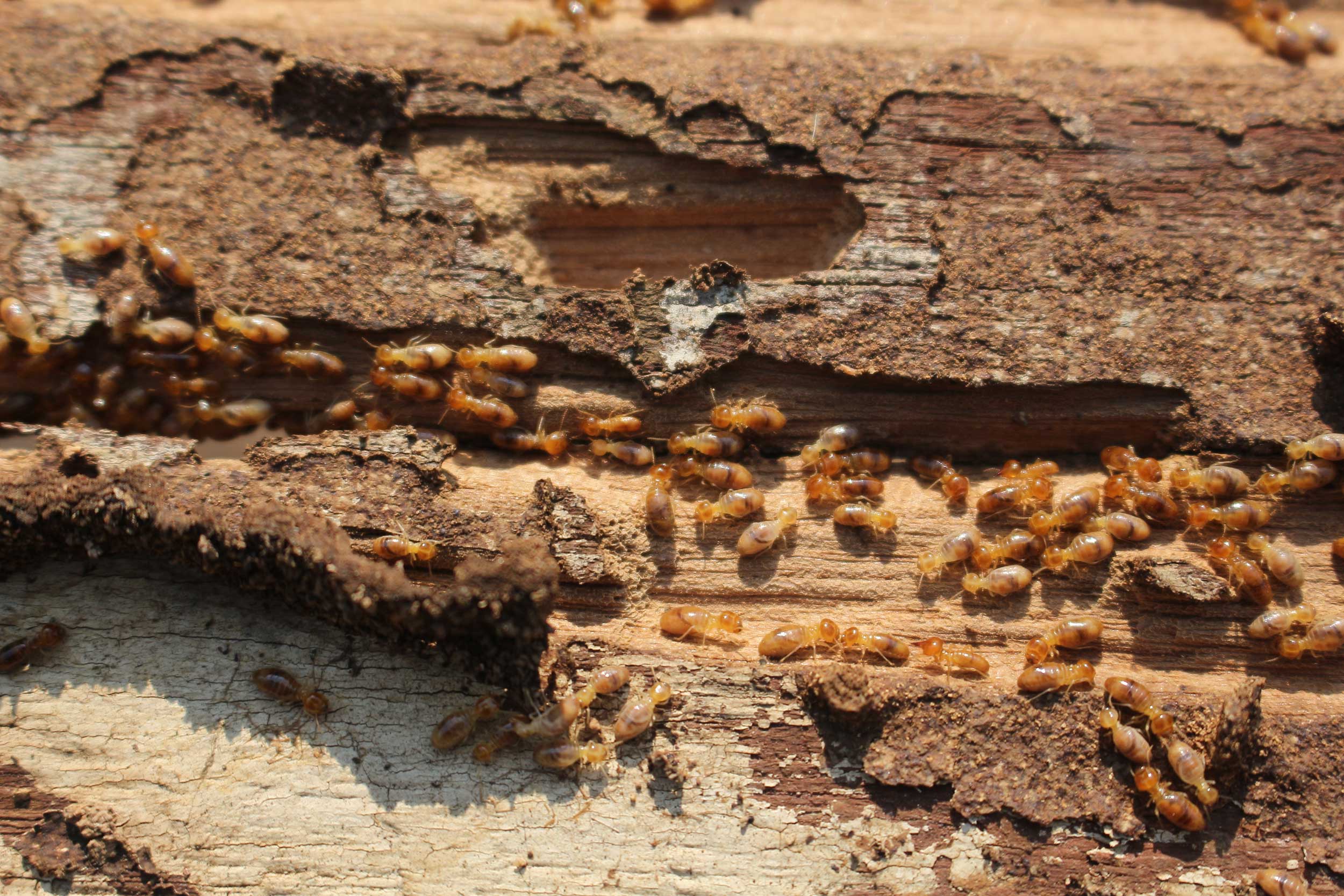Welcome to the ATX Pest Podcast, episode 2, subterranean Termites. So it is the beginnings of swarm season for termites right now. We’re actually getting quite a few calls. The last couple days Kind of just popped, which is pretty normal. We had a really mild winter so it was kind of really it’s about the same same time of year in general, sometimes could be a little earlier, usually it’s a little bit later, um, but in april nonetheless, usually the swarm really starts taking place, sometimes a little bit earlier, um, and I imagine they’ve been starting this form within the last week or so. So some folks might have noticed I think we might have had a call or two um two weeks ago possibly, but we’re getting them regularly now. So form season is upon us has to do with the correct temperatures. Rain, humidity is when they will come out of their nesting areas or colonies and then the winged termites, the swarmers or the winged reproductives, will go off on what we call their mating flight. They’re going to go, look for a place to find a companion and somewhere to mate and create another colony, and that’s why they spread, spread so rapidly every year. Okay, and there’s a lot of things that you can do to try to help prevent that. As far as lighting around your house, they’re really attracted to that and so trying to limit that, among other things, what we can get into as some tips to help try to prevent this from happening. Okay, we’ll talk about that, but a little bit more about termites.
So we deal with primarily the eastern subterranean termite. They’re found all over the united states, um, all the way up to southward, like ontario, um to the, and from the eastern united states seaboard as far as far west, all the way to mexico, arizona, um, and like the utah area, okay, um. And then there’s a species called the western sub. They’re usually found along like the pacific coast, western mexico and um, and east into the, into like idaho and surrounding areas, um, termites are social insects. They live in very large colonies, okay, um. And like ants, okay. Their colonies can can range from like 50, 60, 000 up to 250. 300, 000 is kind of the broader, which is a huge range, but I would say average. You want to take an average of that and you look at 100 to 150,000 on an average colony, most likely, but colonies numbering into like half million, into the millions is actually possible, which is crazy. That’s a lot of termites. But to have a termite colony with a million plus happens, um, but on average you got smaller little individual colonies, um, maybe a couple hundred thousand. So that’s what the data shows.
Anyways, um, ways, um, and who really honestly knows, right? Um, a queen can live up to 25, 30 years and workers live as as long as three to five years on average. Um, so they, uh, they stick around for quite some time and, as you can imagine, it’s why they, in high numbers, like that once they get established into a home. It’s not if they just set up shop there and they’re going to get into the front exterior wall void of your home. Let’s say, that’s where you have your little den spare bedroom, up in the front of your house and they just get into that wall, boy, find a two by four and just eat on that for the next couple years or so. That’d be great if that’s all they did, so we could knock that activity. The problem is and the best way to explain this, if you can envision branches on a tree tunneling underground. Well, once they run into a structure, they’ll use like a root foundation, whatever, as a guide, and then they’ll find food, essentially wood. Okay, they’re the biggest recyclers that we have in the world. They do an amazing job of that. We just don’t want them getting out of their homes. But what they’ll do is they’ll establish time, they’ll establish a feeding trail, and it’d be great if that’s all they did. But the problem is with them is they never stop. Okay, they will break off. Typically look on a 45 degree angle from that current food source and then, boom, all sudden they might hit the other corner of your house or your fence or your neighbor. So it’s just the ongoing process. So having your home protected all the way around the perimeter of your home is very vital. They do billions worth of dollars with the damage a year and it’s kind of that, like I look at it, as a silent killer. It’s kind of like having high blood pressure for 15, 20 years and you didn’t know it and then all of a sudden you stroke out or have a heart attack. Well, that’s kind of like termites what they do. They’re going to destroy your home and if you let it go for a number of years it can be actually quite catastrophic On average. Usually you catch it, you know, did a little bit of damage, but nonetheless you have damage. So that’s no bueno, right. So termite protection having an annual inspection is Very much recommended.
Okay, there is Drywood termites as another species. We don’t really deal with those in the Austin area at all. I’ve only encountered it one time and it was a lady that lived in Georgetown. She moved from Arizona and she found these little pellets and I said, wow, it really what she was describing really did sound like drywood termites. And so I actually went to her town home that she lived in and she had a a picture frame that she brought with her when she moved. And sure enough she had dry wood termites in that picture frame. Nonetheless, you know, say she, she asked me to throw it away from her, so I did, but that solved the problem. Luckily they didn’t transfer anywhere inside the house. So that was a good thing. A little lucky too. But things that you can do other than you know, obviously, getting an annual inspection, having a traditional liquid treatment barrier protection done around your home or doing a baiting system around the home, like we do both I do both at my company. A lot of companies do both there’s, you know, some people like using different products on the market. To my decides I only use one that’s called Termidor, high Efficiency. To me it’s one of the best products there is. It’s also expensive, but it’s expensive for us anyways. We don’t really charge extra because we’re using a bit, and when I’m talking about more expensive, it’s it’s a few dollars a bottle more than what other companies are using. So it’s not, it’s not a huge increase in price at all. And a good company out there they’re using Termidor, like we are. So there’s a lot of us, a lot of companies that cheap out and they’ll use different active ingredients that are can be considered a termiticide, a true termiticide. Termidor is active greens called fipronil, and fipronil is actually what’s in flea and tick collars for dogs, which is obviously an extreme minute amount in a dog flea and tick collar, but nonetheless it is the active ingredient that we utilize and to me, for me, is the only one I will for termite, for subterranean termites. Okay, now the baiting systems that a good company should be using is an annual inspection, one that’s already pre-baited. Companies that are going to sell you on that annual, already baited system and they’re going to tell you that they need to come and charge you quarterly to come inspect it are just gouging you and taking advantage get rid of them. It’s not necessary. The beta has been found to last for quite a few years and what a company does is we’ll go and we’ll inspect it and change out bait as necessary. And it’s just a wonderful system compared to the old ones weren’t baited, they had a little blocks in there, wooden blocks, and we would have to go and check those quarterly at least, and we found activity. We would take them off, put some bait in there and then some follow-ups and keep doing follow-ups, inspecting that and ensuring that we got rid of the activity. Well, this way we may not get there for a little while in between a quarter. Well, now you don’t have to worry about that Immediately. They’re going to start getting treated, getting dosed so much better. Technology is great sometimes, so I really recommend.
I’m a big proponent on baiting. It’s been proven to be pretty much just as as effective as liquid treatments. And there is a huge argument and I will argue this because, yes, I think using liquid can be and when I’m talking more efficient, we’re talking next to nothing, I mean half a percentage. But the problem is is when companies do liquid treatments, it has a lot of technician error involved. They didn’t spray enough product because it calls terminator, calls for, say, two gallons of finished product at a 0.06% concentration in a 10-foot section along your foundation, your home, but they only got a gallon and a half down in that area. They miscalculated and you know, then spray it. They just got distracted. Or just, quite frankly, they don’t have a meter on there, they don’t know what they’re spraying, they didn’t calibrate before they got started. They have a patio to drill and put liquid down in there. They didn’t calibrate properly, they didn’t put the proper amount or they didn’t drill all the way down and get into the below footer, get into the soil. I mean there are so many variables of involved with doing a liquid treatment that you have to treat typically with liquid to take care of a current active. Already you know a problem that’s going on. You already have termites. But other than that, I put more faith in overall using a baiting system just because of everything that I mentioned and it’s proven to be extremely effective. And there’s really two on the market. One’s called centricon, they’ve been around, dow Agro owns them. They’ve been around forever. And then you have Treloan, a BASF owns them. That’s what I use, the studies I’ve seen. I Just prefer them and then for other reasons too, is that I actually own the stations. Dow Agro was a little too proud of themselves. They want to charge you for it and really the cost comes up to be really the same for us. You know pest control company, they’re using them or not. But it’s just the point. There’s reporting that has to be done. You have to send them, you know, cut them a check every quarter. It’s just the point. There’s reporting that has to be done. You have to send them, you know, cut them a check every quarter. It’s just extra work to involve with it and then typically companies will charge you a little bit extra because of all that, versus I don’t have to do all that. So we’re typically can be a little bit slight, slightly cheaper, so kind of a win-win for can be a little bit slightly cheaper. So kind of a win-win for the business and also a win for our customers as well. So that’s what we use. We use Trellana. It’s a great system. If anybody has any questions about that, you can always call me. I’d be glad to share some information with you with that.
But termites have begun, swarm season has begun. Limit lighting. I would make sure you don’t have firewood stacked up brush piles in your yard, things of that nature. If you have a smoker, have you burn wood for a fireplace in the winter time? Store that wood is honestly as far away from your home as possible. Don’t start right up against a fence either, um, but at least 50 feet away from a home is kind of the recommendation usually. So make sure you don’t have a lot of standing water moisture involved around your house. Those are conducive, what we call conducive conditions. Don’t have a wooden fence or attach a a garage and you wood to the structure. That’s considered a conducive condition and your pest control company may avoid your warranty because of it. If you already have one just an FYI, and of course you never find out you’re gonna have a warranty. Void it until you know you have a problem. Then you’re screwed. So you don’t want to do that. But you know there’s a lot of moisture. People don’t know this. But not only will that cause problems for mosquitoes and, you know, ants and beetles and everything else. Really, mulch is a big thing too. If you’re going to mulch your yard, which I’m getting ready to do myself. That was cedar, but you have to remove the old mulch. If you just throw mulch upon mulch, you’re going to create several layers of decay, it’s going to hold more moisture and that’s just an ideal breeding site. Okay, so you don’t want to. Also, too, you have to make sure that you have enough, let’s say, at least four to six inches exposed of your foundation. Okay, you do not want to cover up that foundation at all, because you will not be able to see a mud tube that a subterranean termite is going to make. And that’s typically how we find activity. More times than not is by foundation inspections, and there’s a lot more that goes into the inspection tapping wood. I mean, it’s a good company, a good company’s is going to come in, tap on all your baseboards around your doorways and tap your windowsills. I’ve tapped windowsills and my finger went right through it and it looked brand new painted. It looked like a brand new construction. It looked like freshly painted even. And I went to tap it with my handle, my rubber screwdriver or my finger, and my finger went right through it because termites been feeding on that for a couple years and the homeowner had no idea. So that’s why it pays to get an inspection done and look us. Pest control companies do free inspections for termites, so you have nothing to lose. So. So I hope this helps.
I could ramble on talk about termites probably for a couple more hours, but I just want to get some basics out there, get a little awareness, a little knowledge. Yeah, get a termite inspection Clean up your yard. I hope this helps. I appreciate you listening in. Hopefully you learned something. If you have any questions for me personally you want to ask me about anything more about termites further or anything else, you can give me a call, 512-588-2998. Or email me at damian@evofoampest.com. Y’all be good, we’ll talk again. Episode three




